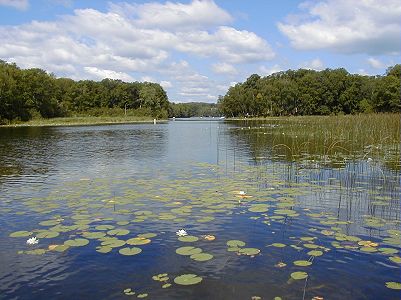|

 |
| Zebra Mussels |
Have you ever thought of how important weeds are in our area lakes? Many times when we are fishing either through the ice or open water fishing we think of weeds as a pest, our baits get hung up! It gets hard to fish in and sometimes just plain frustrating…. We are writing this article to show how important these plants are to fish and to the general condition of your lakes.Aquatic plants form the foundation of healthy and flourishing lake ecosystems – both within lakes and rivers and on the shores around them. They not only protect water quality, but they also produce life-giving oxygen. Aquatic plants are a lake’s own filtering system, helping to clarify the water by absorbing nutrients like phosphorus and nitrogen that could stimulate algal blooms. Plant beds stabilize soft lake and river bottoms and reduce shoreline erosion by reducing the effect of waves and current. Healthy native aquatic plant communities help prevent the establishment of invasive exotic plants like Eurasian watermilfoil.
Zebra mussels, Eurasian watermilfoil, gypsy moths, multi-colored Asian lady beetles, garlic mustard and buckthorn are biological bullies-and worse. They displace native species, disrupt ecosystems, and affect citizens’ livelihoods and quality of life.
Common Weeds of Northern WI Lakes
Here I will describe the importance of weeds in relation to fish and cover. They hamper boating, swimming, fishing and other water recreation, and take an economic toll on commercial, agricultural, and aquacultural resources.
These and hundreds of other plants, animals and pests from other regions and continents are invading Wisconsin lakes, rivers, forests, wetlands and grasslands.
 |
| Purple Loosestrife |
Purple Loosestrife – everyone thinks what a beautiful plants – this is an invasive plant and not only can take over ponds and lakes but spreads tremendously in watershed area and roadsides. The plant will provide shade and cover in a lake but is really a nuisance plant.
 |
| Elodea |
Note the bright green color of this weed – this shows this plant is healthy. This plant has several local nicknames everything from walleye weed to musky or pike weed. This weed usually occurs in different areas and grows in-groups or 4 or 5 plants. At times this plant is associated with other plants such as elodea and coontail . Many times you will see this weed grow up to 3 or 4 feet depending on the type of lake.
 |
| Coontail |
 |
| Eurasion Watermilfoil |
Coontail many times grows in very dense beds. Panfish and minnows will hide in these areas. Largemouth bass will frequently hang out in pockets of these weeds waiting for baitfish to move in and out between the beds of weeds. Again note the green color indicates good oxygen. In fall many times when water temperatures start to drop some weeds such as the Large-leaf Pondweed will start to turn brown, indicating die off of that plant.
Large-leaf pondweed will grown around shorelines (lily ponds) usually in a few feet of water. Again panfish and minnows will take cover in these areas. These weeds provide great cover for largemouth bass and at times smallmouth bass. Many times this plant is in sandy/gravel areas. You will not frequently find this plant in a mud type substrate.
 |
| Clasping Pondweed |
 |
| Large-leaf Pondweed |
What types of weeds are walleye cover?
Some of my favorite fishing occurs in the weeds! I love jigging and presentation sometimes can get frustration working in weed beds. Elodea and the Clasping pondweed along with coontail are some of my favorite areas to catch walleyes.
I do not usually fish the dense matted beds with this type of weed but fish the drop off. Again jig fishing in the weeds can get frustrating as many times people will have tough time telling if a walleye is biting. Sometimes walleyes will just hold the bait in it’s mouth but at times if you hold your rod stead you can feel movement – always set the hook with a good hookset.
Conclusion
Fishing the weeds can be challenging but with patience it can be very rewarding. I hope this article helped you become familiar with some of our common aquatic weeds in Northern WI. If you have any questions at all feel free to contact us at:
Captain Marty Papke
800.708.2347
or Email us at:
martyp@littlebaydenoc.com
http://www.littlebaydenoc.com |